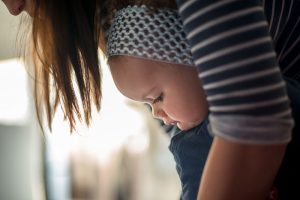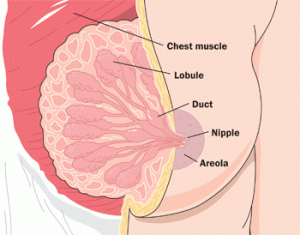
Low Milk Supply Breastfeeding
The number one cause of low milk supply breastfeeding is disruption in breastfeeding. For example, when the pain caused by sore/cracked nipples aggravates while breastfeeding, that in turn forces yourself to do, say a four-hour routine, instead of breastfeeding on demand; this will become a disruption in natural breastfeeding.
Another cause of low milk supply could be hormonal imbalance (e.g. hypothyroidism).
Other causes include breast surgery, medication and losing a huge amount of blood while in labor.
Another interesting fact is that low milk supply can be attributed to the baby’s sleepiness. If the mother is unable to feed at night because the baby is very sleepy, the level of prolactin (the hormone that alerts the breasts to produce milk) production slows down. Apparently, prolactin is more active at night than the day. Hence, feeding at night gives a signal to continuously make milk.
We talked about ways to ensure healthy and balanced milk supply for breastfeeding here.
Sore and Cracked Nipples
Bear in mind that a few days of breastfeeding will naturally bring about sore nipples. What if the pain exists for a couple of weeks from the first time you have breastfed? What causes sore nipples anyway?
First is difficulty latching on and this is the most common cause of sore nipples. If it hurts, just start with the whole latch on process again. Also, if you intend to repeat the latch on process, do not just pull your nipple out; instead, insert your finger into the corner of the baby’s mouth just above the tongue. Start teasing the infant’s lip soon after.
Second, aside from being sore, if the nipple starts to crack or bleed because of irritants like soap or washing detergent left on clothes, you may:
- Apply lanolin ointment to the affected area;
- Wet the affected area with a few drops of breast milk since it contains substances that aids in healing and rounds infection too;
- Wash the affected area only with warm water;
- Consult a doctor if you are still uneasy despite all the healing methods are tried.
Sore or cracked nipples will not affect the baby. Even a little blood in the milk will not even affect the child. If you can bear the pain then you may definitely go ahead with breastfeeding. Otherwise, you may extract milk and have it stored in a bottle for your baby until you fully recover and can go on with breastfeeding.
Thrush
Sore nipples may also indicate thrush. It is a fungal infection that develops in warm, sugary and moist places like the baby’s mouth during breastfeeding.
Most probably, you know that it is a thrush symptom when there is a burning sensation in the breasts. The nipples are itchy that even donning a loose top can become uncomfortable. Nipples become reddish and shiny and become too sensitive to touch.
The tricky part here is that, some moms may not even notice the symptoms of thrush. Thus, if the baby starts to develop white patches that look like cottage cheese or milk curd on the roof of the mouth, tongue and gums, which cannot be wipe away easily, chances are the child may have been affected by the fungal infection. Thrush can also cause diaper rash since the infection passes through the digestive system, excretes it through the feces which gets into contact with the skin protected by the diaper.
In this case, it is best to see a doctor. At home, wash and sterilize all the toys your baby puts in the mouth, kill the fungus in your and your child’s clothes by washing them at 60ºC, wash hands often and you may integrate probiotics to your diet (example of foods with probiotics are miso, kimchi, pickled vegetables and yoghurt) to subdue thrush.
Engorgement
The breasts have a very high milk-supply, so much so that they become hard and difficult to latch on to. The solution to this is simple: feeding on demand. It means feed whenever the baby wants, for as long as the baby wants. This keeps the milk supply on a balanced level.
What if after feeding the baby, your breasts still feel uneasily engorged?
You can definitely express your milk. The term expressing (in breastfeeding) means to take milk from the breast without the baby sucking for it. Expressing milk can be done either by hand, a manual pump or an electric pump.
An interesting tip to ease the pain of engorged breasts: place fresh cabbage leaves (preferably chilled from the fridge) in between your bra.
Inverted nipples
Stimulate your nipples – do they retract or protrude? If they retract then there will be a bit of a challenge in breastfeeding.

Inverted Nipples
Fret not though. All it takes is to express some milk by the use of your hands or with a pump until you can draw the nipple out. This may seem a bit time consuming but remember that practice makes perfect.
Once you have become more experienced in breastfeeding, you will be able to get the correct timing to have your nipples protruding and ready for feeding.
Blocked ducts
When milk is not drained completely, the ducts (tubes that carry milk from the tissues to the breasts) get clogged leaving a hard lump on the breast plus soreness and redness. A bleb (a spot about 1mm in diameter and is colored white) is also formed by those fragments of fatty material from the milk.

Nipple Structure
Blocked ducts can be caused by long stretches of non-expression of milk, a bra that is too tight and even stress.
To get rid of blocked ducts caused by bleb, gently rub it with warm, clean, damp flannel after taking a shower. Give the affected breast to the baby to make sure it is completely drained. See to it that the feeding gap is well balanced (if you cannot feed on demand) and that the baby is latched on properly every breastfeeding session.
Mastitis
This is mostly caused when the breast makes milk faster than it is dispensed (milk stasis). The “progression” is from breast engorgement to milk stasis to mastitis wherein the mother will now experience chills, headache, exhaustion and fever. Aside from the causes mentioned, you can get mastitis from clothing (e.g. tight bra), breast injury or by simply the infant favoring one breast over the other.
As a solution, continue to feed the child on the affected breast, as mastitis becomes worse if you seize doing so. Expressing milk, feeding on demand and proper latch on are integral components in getting rid of mastitis. Gently massaging the breasts while feeding help circulate the flow of milk too.
I hope you enjoy this little post and feel free to chime in with a comment. Let me know if you have any personal review or experience, or if you have any questions about the post. 🙂
Have fun breastfeeding and if you like this post, do share it with your family and friends. After all, sharing can always accelerate and make the learning curve easier for new or expecting mothers!
This article is full of good information for new mothers that are breastfeeding or planning on it. I will be forwarding this article to my daughter in law who will be having a baby soon. I was glad to see that you mentioned continuing to breastfeed with mastitis. I had this with one of the children and many people tried to advise me to quit nursing. I didn’t and everything worked out for the best.
Thanks…
I am not sure if it was just me or what was happening; however, I could not get your website to load which I was very sad about because I was excited to read what you had to say on the topic. I would try to get in touch with support. I am pretty sure it is not my computer because everything else on the computer is working fine.
Thanks…
When I had both my kids, I wasn’t successful at bf. At that time, there was not much info on bf like now where everyone is like crazy with bf. I didn’t know what went wrong. Both my kids unfortunately were detained at the hospital due to jaundice. I didn’t pump because I didn’t know I had to pump every 3-4 hours. I didn’t bf as and when the baby wants. So, ended up with engorgement. It was so painful. The cabbage didn’t work to relieve engorgement. My mom said to try comb it slowly. I tried hand pressing while in hot shower but to no avail. In the end, what did work was me sitting down for so long hand pressing all the milk out slowly until I had headache and my shoulders and neck were so painful. I wish I had known back then to feed on demand. Did you experience any of these symptoms yourself? What worked best for you? I can share this with my friends so that they don’t repeat the mistakes that I did. Nice post, by the way. Thanks for sharing.
Hello,
I always wanted to breastfeed my baby.
The first day was a very big challenge as I didn’t have any milk. I was quite worried but thank God the milk came later.
Then, a few weeks later, I got thrush on my nipples. It was so painful that I hesitate to continue breastfeeding.
But, I didn’t want to give up.
I have tried cream from the pharmacy that didn’t really work. Then, I saw my doctor who prescribed an anti fungal cream and a medication for baby to put on his tongue.
Within a few days, the burning sensation on my nipples went away.
Nathalie
Thanks…
I have read your article twice just to make sure I don’t forget. I am preparing for breastfeeding my second child. I haven’t been successful with my first child, and I don’t want it to happen again. Knowledge in breastfeeding is your best weapon when the problem is already in your face. You site an excellent help for mothers who want to be successful in breastfeeding and overcome breastfeeding challenges like this list.
Thanks…
This is really good article , i had much difficulties while breastfeeding my sons , this will definitely help some moms out there i also have friends struggling with this problem i will show them this site so they can take some notes from it and hopefully it can help them.
Best regards Thora
Thanks, Thora. Yes, hope this can help you as well as your friends. Cheers.
Another well documented post about breastfeeding. I think that your post is straight to the point about the issues of lack of milk, something that we all have confront while we were breastfeeding our babies. I really like the way you write. I am a fond of simplicity and accuracy and that’s what your post give to me.
Your’s,
Rebecca
Hi Rebecca, glad to receive your positive comment again. Thank you so much! Your kind words are definitely a booster for us to keep on improving. Cheers~
Great info! I am happy to see someone sharing tips on breastfeeding. I think that people quit much too soon and too easily without even giving it a real go. I’m so glad that I breastfed my daughter and I recommend it for anyone who has a baby.
The hard part for me now is weaning my daughter, lol. Even after a full meal and glass of milk she still wants breast milk. I’m not complaining though, just saying.
Hi, Marlinda! Thank you for dropping by here and leave such a great comment. It’s a good thing that you hang on and breastfeed your daughter as much as you can. And the most important thing is that you had enjoyed the process as well. Wondering how long you have been breastfeeding your daughter, the day that should come will still have to come, when your daughter can be weaned fully. How old is she?
I wish that I knew more about breastfeeding when I had my 3 kids. I didn’t have any help and it was a difficult experience. In the end, I just gave up as there wasn’t any support. I did experience mastitis and I also tried the cabbage patch treatment. It did help to relieve the condition somewhat. Thanks for sharing this post.
Oh no, it’s so sad to learn that you just gave up breastfeeding as there wasn’t any support. What a pity! But glad to know that the cabbage patch treatment did really relieve your mastitis, which re-confirms our claims in the article. Thank you Yvonne for sharing your personal experience here. I hope our site here can have an opportunity to support you again in many other ways in the future. Cheers~ =)
Thanks for a great overview on potential breastfeeding pitfalls! I’ve been nursing for almost 17 months now. In the beginning my nipples were sore and our latch was off (due in part to a mild tongue tie), but we kept at it, and now it’s my favorite part of our routine! The amazing bond we share is worth all the problems and trouble shooting we had in the beginning.
Thanks for stopping by again, Melissa… I’m happy to hear that latching becomes your routine’s favorite part. Happy breastfeeding happy bonding. 😉
WOW!… this is a great post. First, I’m a man, but I can recognize the importance of the topic, because I’m a health student (Therapy) and I will be a father in the future, this information is so valuable.
I had heard about the Low Milk Supply Breastfeeding from girl’s partners/ mothers in class, but now I can share this post with them. Thank you so much.
Hi Giancarlos, thank you for your kind compliments. Yes, that’s awesome! Glad to know that you’ll share this post with your classmates. Really appreciate that. Cheers~
Oh my.
I’ve always wanted to breastfeed my kids in the future (when I have them) and thought that it is a very simple matter. Looks like it’s not and there are many problems that we can run into x.x Perhaps breastfeeding isn’t the most optimal choice after all. It seemed so simple when everyone speaks about breastfeeding – just put your baby’s mouth towards your nipple. But who would have thought about low or excess milk production, fungal infection, and problems during latching?
Just curious, does a small breast size indicate low milk production?
Hi Rachel, thank you for your brilliant feedback! No, breast size is irrelevant to low milk supply. A woman’s breasts size is dictated by the amount of fatty tissue they contain. However, this tissue has nothing to do with the milk production. Hope this helps. =)
Want to know how to increase milk supply when pumping? You can check this article out.